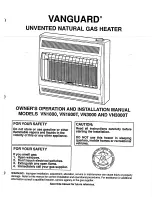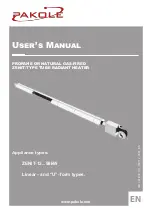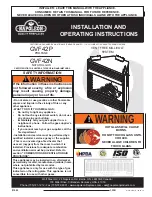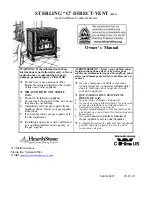
9
SECTION III: INSTALLATION INSTRUCTIONS
CAUTION
If building cold water supply has a back-flow preventer, check valve or water meter with check valve,
provisions for thermal expansion of water in the hot water system must be provided.
WARNING
Pressure relief valve discharge piping must be piped near ground or drain to eliminate potential of
severe burns. Insulate and use electrical heat tape around the discharge drain pipe in any area
where freezing could occur. Do not install any shut-off valves, plugs or caps to the temperature and
pressure relief valve or piping.
DANGER
Temperature setting should not exceed safe temperature at fixtures. See water temperature control
warning in the “Temperature Adjustment” section of this Installation and Operation Instruction
Manual. If higher preheat temperatures are necessary to obtain adequate booster output, add an
ASSE approved mixing valve for hot water supplied to fixtures.
WARNING
INSTALLATION OF THIS WATER HEATER REQUIRES ABILITY EQUIVALENT TO THAT OF A
LICENSED PLUMBER. Plumbing, air supply, venting, gas supply and electrical work are required.
DO NOT ATTEMPT TO LIGHT ANY GAS APPLIANCE IF YOU ARE NOT CERTAIN OF THE
FOLLOWING:
Liquefied petroleum gases/propane gas and natural gas have an odorant added by the gas
supplier that aids in detection of the gas.
Most people recognize this odor as a “sulfur” or “rotten egg” smell.
Other conditions, such as “odorant fade” can cause the odorant to diminish in intensity, or
“fade”, and not be as readily detectable.
If you have a diminished sense of smell, or are in any way unsure of the presence of gas,
immediately contact your gas supplier from a telephone in another building.
Gas detectors are available. Contact your gas supplier or plumbing professional for more
information.
Liquefied petroleum gases/propane gas is heavier than air and will remain at floor level if there is a
leak. Basements, crawl spaces, closets and areas below ground level will serve as pockets for
accumulation of leaking gas. Before lighting, smell all around the appliance area for gas. Be sure
to smell next to the floor.
IF YOU SMELL GAS:
Do not try to light any appliance.
Do not touch any electric switch; do not use any telephone in your building.
Immediately call your gas supplier from a telephone in another building. Follow the gas
supplier’s instructions.
If you cannot reach your gas supplier, call the fire department.
DO NOT OPERATE THE APPLIANCE UNTIL THE LEAKAGE IS CORRECTED!
Содержание EverHot TG-150E-N
Страница 20: ...20 Figure 6 Recommended Piping for a Basic Installation...
Страница 21: ...21 Figure 7 Recommended Piping for a Circulation Systems...
Страница 25: ...25 Figure 9 Recommended Piping for Combination Water and Space Heating Applications...
Страница 31: ...31 Figure 11 Wiring Diagram for TG 150E N X TG 180E N X and TG 199E N X Models...
Страница 32: ...32 Figure 12 Wiring Diagram for TG 237E N X and TG 237E N X A Models...
Страница 51: ...51 SECTION IX PARTS LIST TG 150E TG 180E and TG 199E Models...
Страница 53: ...53...
Страница 55: ...55...
Страница 57: ...57...
Страница 59: ...59 TG 237E Models...
Страница 61: ...61...
Страница 63: ...63...
Страница 65: ...65...
Страница 70: ...70 NOTES...
Страница 71: ...71 NOTES...










































